Automated Training: How to Streamline Employee Development

Automated training streamlines workflows, reduces costs, and delivers scalable learning experiences. It benefits employees and businesses alike — for example, employees can access personalized training programs that fit their roles, while businesses save time and resources.
Automation definitely offers many benefits, but getting started can be challenging. You need to assess your needs, tackle technical issues, manage changes, and address compliance concerns.
In this guide, we’ll break down everything you need to know to get started with employee training automation — its benefits, implementation steps, and the challenges you might face along the way.
P.S. If you don’t have time to figure out how to automate your unique training process, you can get help from our L&D experts.
What Is Automated Training?
Automated training uses technology to streamline and simplify employee training processes. It transfers repetitive administrative tasks — like assigning courses, tracking progress, or sending reminders — from people to programs. This makes the entire process faster, more efficient, and scalable.
Automation frees training staff to focus on more meaningful tasks, such as defining learning objectives, course design, and high-quality content development. This process often occurs online through a learning management system (LMS), which serves as the core automation platform to manage and deliver employee training programs.
Also read:
- LMS Benefits for Recruiters, HR, and Sales and Commercial Directors — Expert Opinion
- Retail Sales Training – How to Move It Online
When Do You Need to Automate Training?
Automating employee training can be a smart move for companies in the following scenarios:
- A high volume of training. When an organization needs to train a large number of employees, automation can significantly reduce the time and resources required.
- Repetitive training content. Automation is particularly effective in delivering standardized training content that needs to be readministered frequently, such as compliance training or product knowledge updates.
- Limited training budget. Automation can help organizations reduce training costs by eliminating the need for instructors, travel expenses, and physical materials.
What Are the Benefits of Automated Training?
We’ve touched on some of the unique and tangible benefits of automated training systems. But those barely scratch the surface! Here’s a closer look at the most common benefits of adopting training automation — for both the company and its employees.
Simplifies scaling and delivery of training
Automating repetitive training tasks streamlines processes and reduces errors due to manual effort. For example, you can use predefined rules and criteria to automate tasks like enrolling users, maintaining accurate training records for audits and compliance, tracking progress, or adding/removing employees.
Automation also uses notification templates and triggers to simplify predictable communications, such as informing employees about required training materials or the duration of a training course. This ensures consistent, timely communication and allows your L&D team to focus on more strategic tasks, like designing employee training programs and enhancing their outcomes.
Reduces costs
Software automation minimizes the time and expenses associated with employee training. While course content design and training development require an initial investment, the real savings come from automating its ongoing delivery process. Businesses can reduce instructor fees, venue costs, and the expenses of printed materials while ensuring that employees receive consistent, high-quality training anytime, anywhere.
Here are some real-world results that illustrate this impact. IMT Matcher switched to iSpring Learn and cut training expenses by 25%. Similarly, Jazz reduced training costs by 30% while training five times more employees with our learning management system.
Boosts engagement and success
With automated training, you can create personalized learning experiences to motivate employees and keep them invested in their growth. What makes the learning process more engaging and interactive are gamification, real-time progress tracking, quizzes, and an instant feedback system, for instance.
This approach also drives real results. Companies that switch to automated training content delivery see higher course completion rates, better knowledge retention, and improved job performance.
For example, Vertin, a funeral home provider, successfully launched online training in just 30 days with iSpring Learn. Now, the average completion rate on the majority of their courses is over 75%.
For businesses, this approach improves knowledge retention, increases training completion rates, and drives better on-the-job performance. Automated training software also offers valuable insights through data analytics, allowing L&D teams to identify what works, refine the course catalog, and continually enhance training program outcomes.
With engaged employees and smarter training strategies, businesses can build more capable teams.
How to Start Automating Your Employee Training Process
Now that you know the benefits of automated training, it’s time to put it into action. A clear plan will help you create an efficient training system that supports employee growth and delivers measurable results.
Here’s a 5-step guide to deploying employee training automation and unlocking its full potential.
1. Identify key training areas for automation
Ask yourself: What do I want to achieve through automation? Do you want to speed up the onboarding process, ensure compliance, or improve skill development? These questions will help you define your objectives and focus on the right areas.
Here are the processes where automation works best:
- Onboarding. Automate paperwork, policy acknowledgments, and training modules to create a smooth training experience for new staff members.
- Compliance training. Ensure that employees complete mandatory courses on workplace safety, data security, and other topics on time. This is especially crucial in automated healthcare training, where compliance with industry regulations directly impacts patient safety and service quality.
- Recurring training. Schedule refresher courses, product improvements, and skill training to keep employees up to date with the latest developments.
- Performance tracking. Collect and analyze training data automatically while keeping feedback and discussions human-led.
2. Choose the right LMS to automate training
Now let’s discover how to find the right software to automate your employee training programs.
An automated training management system, like an LMS, is the core tool for automated training. The biggest hurdle? Choosing the right automated training software from among various options available. Here’s how to find the right LMS platform:
- Identify the level of automation your business needs based on your training content, learning approach (blended or asynchronous), and the size and growth rate of your company.
- Evaluate key automation features, such as self-enrollment, scheduled reminders, certification management, and detailed reporting.
- Define nice-to-have features. For example, a user-friendly interface is crucial for both learners and administrators. Otherwise, the LMS will face poor adoption rates.
- Choose scalable software that will easily adapt to future changes in your training initiatives, whether you’re training a small team or thousands of employees.
- Check integration capabilities. To avoid data silos, the platform should be compatible with your existing HR and business tools.
- Review customer support and pricing.
Check out iSpring Learn LMS if you’re looking for a simple yet effective solution that will automate any tedious, time-consuming tasks and streamline training management.

3. Automate course content creation and delivery
Your eLearning content is the foundation of a successful automated training experience. A mix of interactive materials — videos, quizzes, simulations, and documents — keeps employees engaged and improves knowledge retention. However, manually creating and organizing content requires a great deal of time. That’s where automation tools come in.
With iSpring Suite Max, you can easily create online courses with AI-powered features built in its cloud-based tool:
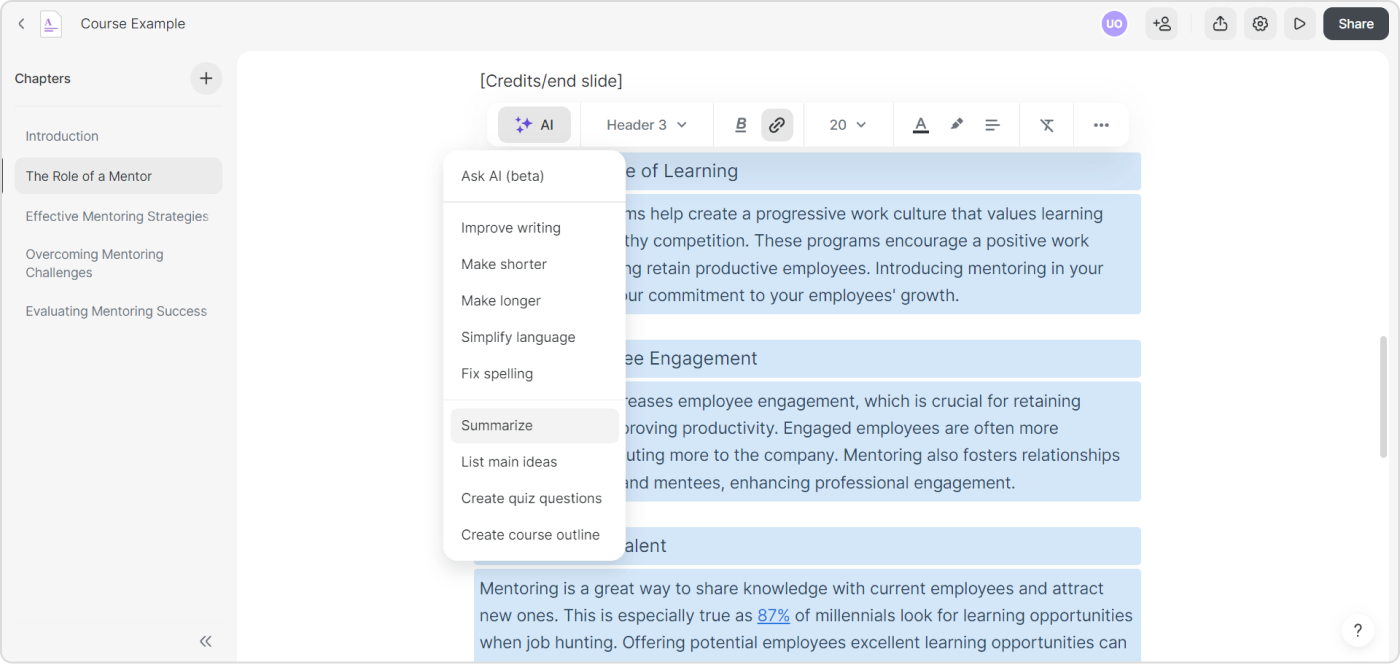
- Generate text-based content, structure courses, and create quiz questions in seconds with the iSpring AI Assistant.
- Turn existing PowerPoint presentations into interactive eLearning modules with built-in assessments, videos, and branching scenarios.
- Organize courses into structured learning tracks, guiding employees through your training content step by step or allowing them to choose their own path.
- Access the built-in Content Library with thousands of ready-made templates, characters, and backgrounds to speed up content creation without sacrificing quality.
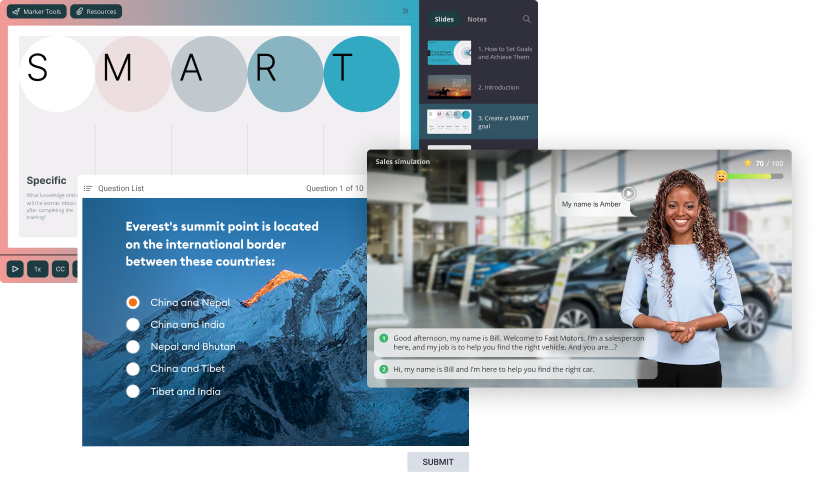
Once your content is ready, the iSpring Learn LMS automates the delivery process. You can schedule course enrollments, set up automatic notifications, and track learner progress in real time. With automation doing the heavy lifting, your team can focus on improving training outcomes instead of managing course logistics.
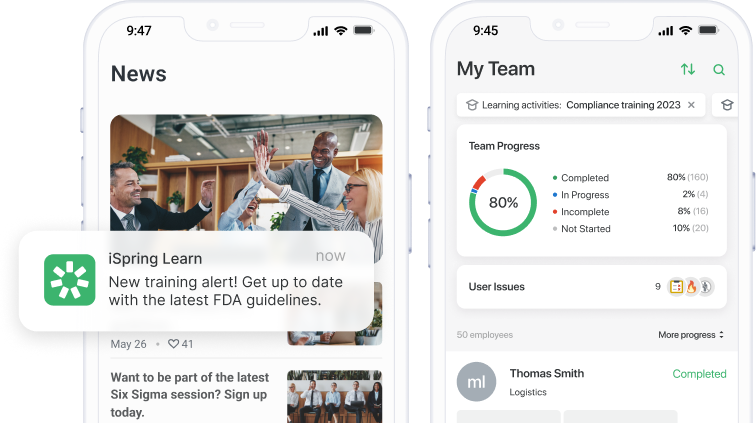
4. Automate training operations
When you have an LMS, you can automate repetitive human resources and admin tasks like managing training records or tracking course completion. This will free up valuable time for high-priority tasks and reduce the risk of human error when inputting trainee data.
Take iSpring Learn, for example. Its “departments” feature mirrors your corporate structure, organizing employees into a tree-like hierarchy of departments and sub-departments. This setup simplifies assigning courses, segmenting reports, and delegating admin roles. You can also create custom groups based on roles or projects, making it easy to auto-enroll employees into relevant training activities. For instance, new hires can be automatically enrolled in orientation courses with minimal manual input.
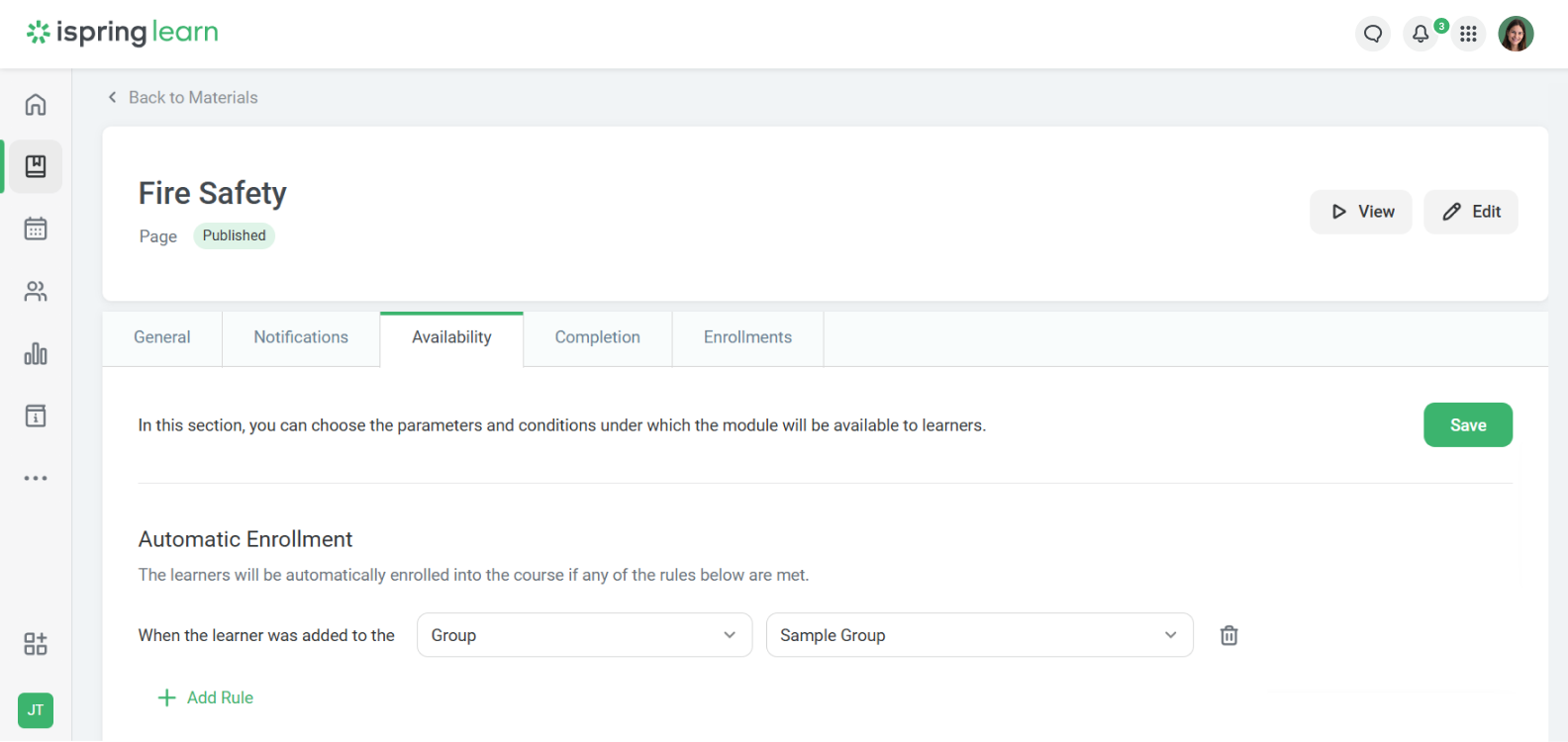
Recurring training is just as seamless. For example, if employees require annual compliance or “refresher” training, iSpring Learn can automatically reenroll them and send reminders before their due dates. Thus, you won’t need constant admin oversight.
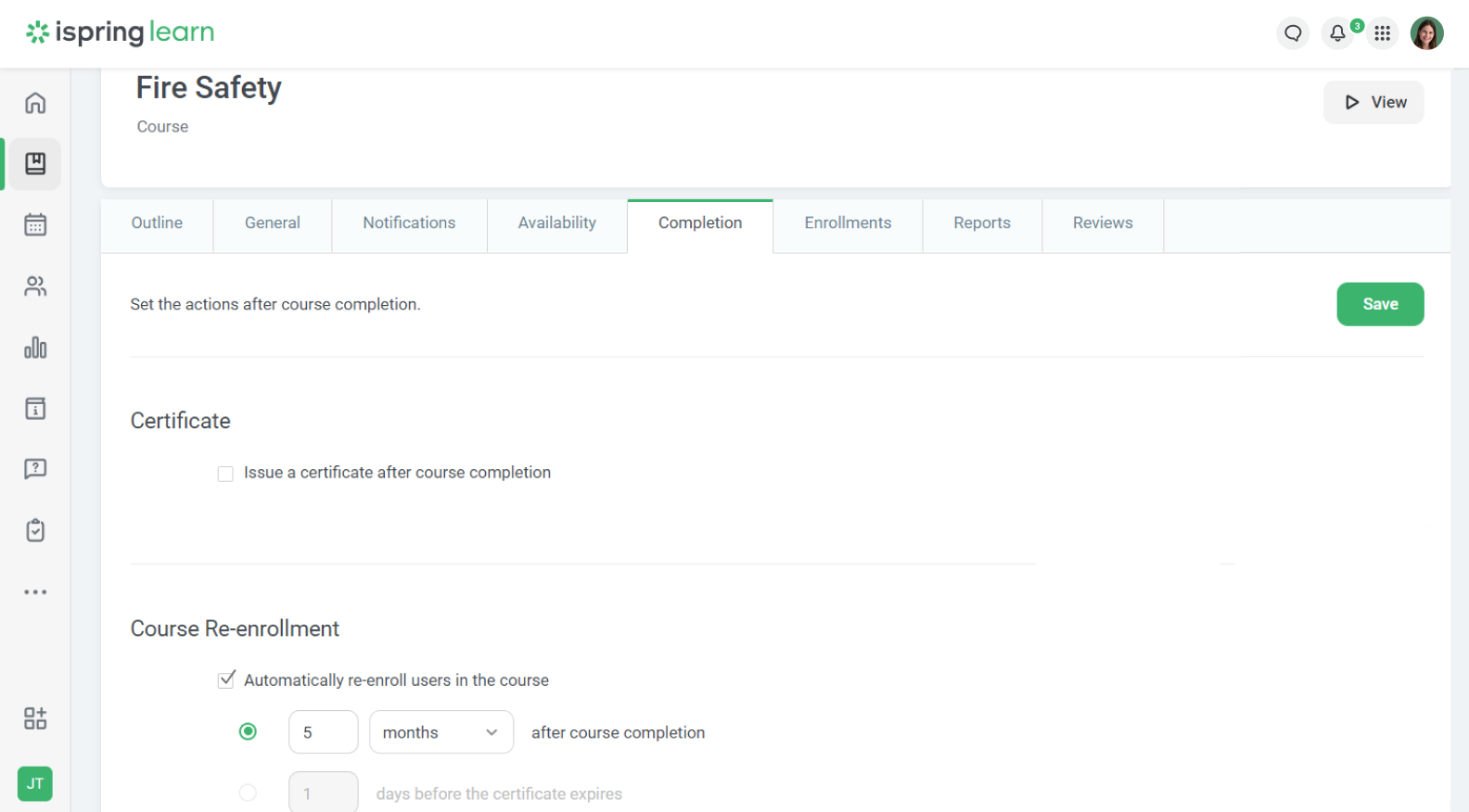
Automation also extends to communication. Notification triggers allow you to send personalized emails for overdue assignments or group reminders on course deadlines. In addition, iSpring Learn automatically generates and distributes certificates upon course completion, saving human resources teams from manual follow-ups.
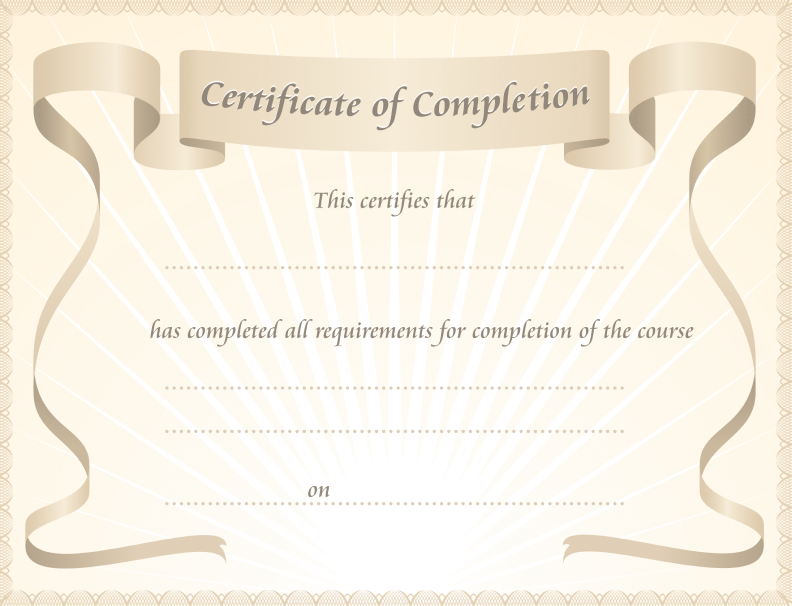
5. Automate reporting and analytics
Once employees begin their training program, it’s time to track their progress and measure their results. This is where an LMS like iSpring Learn demonstrates its full potential, offering comprehensive reporting and analytics to ensure you stay informed.
With iSpring Learn, you can automatically generate a variety of report types: learner progress, course completion, assessment scores, and more.
For example, this course progress report shows, at a glance, which courses you’ve uploaded, how many people are enrolled in each, and the number of individuals whose courses (itemized) are “in progress” or have been completed.
In iSpring Learn, you can send reports to your colleagues’ or employees’ emails. You can even schedule sending reports — just set up who should receive which report once, and the recipients will get a report even when you are away.
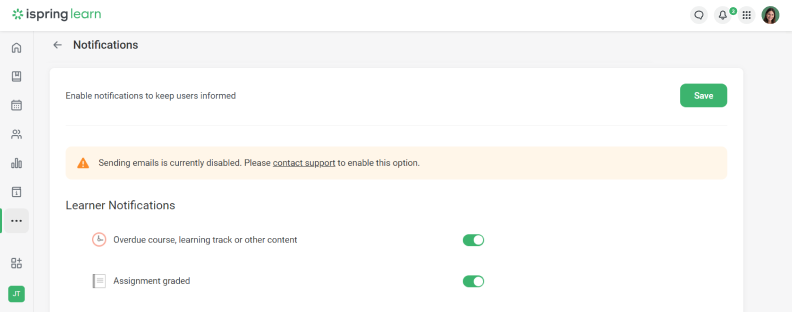
Key Challenges of Automated Employee Training
Even though employee training automation brings flexibility and scalability, there are several challenges that can affect learning effectiveness. Here are some of those obstacles and how you can overcome them:
- Technical difficulties. People may face challenges with LMS navigation, access issues, or compatibility with their devices. In addition, some automation tools require technical expertise for setup and maintenance. In this case, you’ll have to ask their team if any technical support is needed or if they offer assistance from their side. Choosing a user-friendly LMS with mobile optimization and intuitive onboarding can minimize these challenges.
- Security and privacy concerns. The benefits of automated compliance training come with the responsibility of handling sensitive employee data securely. Organizations need to ensure compliance with data privacy regulations and implement robust security measures like data encryption, access controls, and secure authentication. Additionally, employees should be informed about how their data is used and protected to maintain transparency and trust.
- Integration issues. Many companies already use HR and learning management systems, and integrating new automated training tools can be complex. If systems are incompatible, this can lead to data inconsistencies, duplicate efforts, and workflow disruptions. To avoid these issues, businesses should evaluate software compatibility before choosing a solution and opt for platforms that will integrate with existing tools.
To Sum Up
Regardless of whether you’re a small, medium, or large-sized organization, the potential time and cost savings of automated training are limitless.
Rather than displacing human labor, training automation frees you up to focus on meaningful, creative work that necessitates higher-order thinking. Thus, both employer and employees stand to benefit immensely from such an investment.
If you’re still unsure if you need automation and how to implement it into your training process, book a call with L&D experts.







